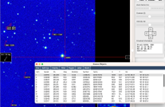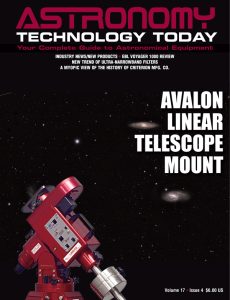Tycho is a software program designed to facilitate the detection and measurement of asteroids, comets, and variable stars. It supports a technique known as synthetic tracking, which enables the detection of very faint moving objects. The publisher has announced that the software now runs natively on macOS.
 To detect both NEOs and MBAs Tycho uses what is known as the synthetic tracking technique. It leverages the graphics processing unit (GPU) to facilitate this technique while also being able to handle large size images. It can easily stack hundreds of images in a short time with GPU acceleration and is compatible with AMD, NVIDIA, and Apple Silicon.
To detect both NEOs and MBAs Tycho uses what is known as the synthetic tracking technique. It leverages the graphics processing unit (GPU) to facilitate this technique while also being able to handle large size images. It can easily stack hundreds of images in a short time with GPU acceleration and is compatible with AMD, NVIDIA, and Apple Silicon.
As the publisher notes, “Synthetic Tracking enables an improvement in signal to noise ratio (SNR) that is not possible with conventional techniques. This increased SNR in turn allows for detection of fast moving NEOs and other faint asteroids This is achieved by using the data from many exposures (a minimum of 11) and applying the stacking technique for an improved signal-to-noise ratio. Because the exposures are stacked in thousands of different possible combinations, synthetic tracking allows for the detection of faint objects even when the motion of the object is unknown. Since 2021, over 100 Near Earth Objects (NEOs) and more than five comets have been discovered by amateur astronomers using Tycho..”
Tycho also makes it easy to construct lightcurves from a series of input images. It features a Period Search module to determine the period from such a lightcurve, and can work with both stationary sources (variable stars, exoplanets) as well as moving sources (asteroids and more).
The publisher also adds, “Detection of moving targets is just the first step. The next step is acquiring accurate and precise measurements of the targets. Using the Gaia EDR3 star catalog, the measurements generated by Tycho can yield residuals better than 0.5 arcseconds on average.”
Tycho runs on Windows 7 SP1 or later and now runs natively on macOS 11.0 or later. You can learn more here.

 And to make it easier for you to get the most extensive news, articles and reviews that are only available in the magazine pages of Astronomy Technology Today, we are offering a 1-year magazine subscription for only $6! Or, for an even better deal, we are offering 2 years for only $9. Click here to get these deals which only will be available for a very limited time. You can also check out a free sample issue here.
And to make it easier for you to get the most extensive news, articles and reviews that are only available in the magazine pages of Astronomy Technology Today, we are offering a 1-year magazine subscription for only $6! Or, for an even better deal, we are offering 2 years for only $9. Click here to get these deals which only will be available for a very limited time. You can also check out a free sample issue here.
The Sun is more active than it’s been in years and if that’s not enough, we have the Annular Solar Eclipse on October 14, 2023 and the Total Solar Eclipse on April 8, 2024! If you’d like to learn more about the technology behind solar observing, solar imaging and more, you can check out our new monthly magazine – Solar Astronomy Today. It’s free to read, no subscription needed and available here. And if you are preparing for the upcoming eclipses and want to know your equipment options from solar glasses to the most out of this world solar viewing and imaging options, check out our free publication – The Definitive Guide to Viewing and Imaging the Sun – simply click here and enjoy reading!

